When you think of banana plants, you probably imagine sprawling groves in tropical climates — but did you know you can successfully grow bananas indoors too? With their lush, oversized leaves and exotic presence, indoor banana plants can instantly transform a room into a tropical paradise. And while it takes some care and attention, growing bananas indoors is entirely doable with the right conditions.
In this comprehensive guide, we’ll show you how to grow bananas indoors, from choosing the right variety to planting, caring, and even harvesting your own homegrown bananas.
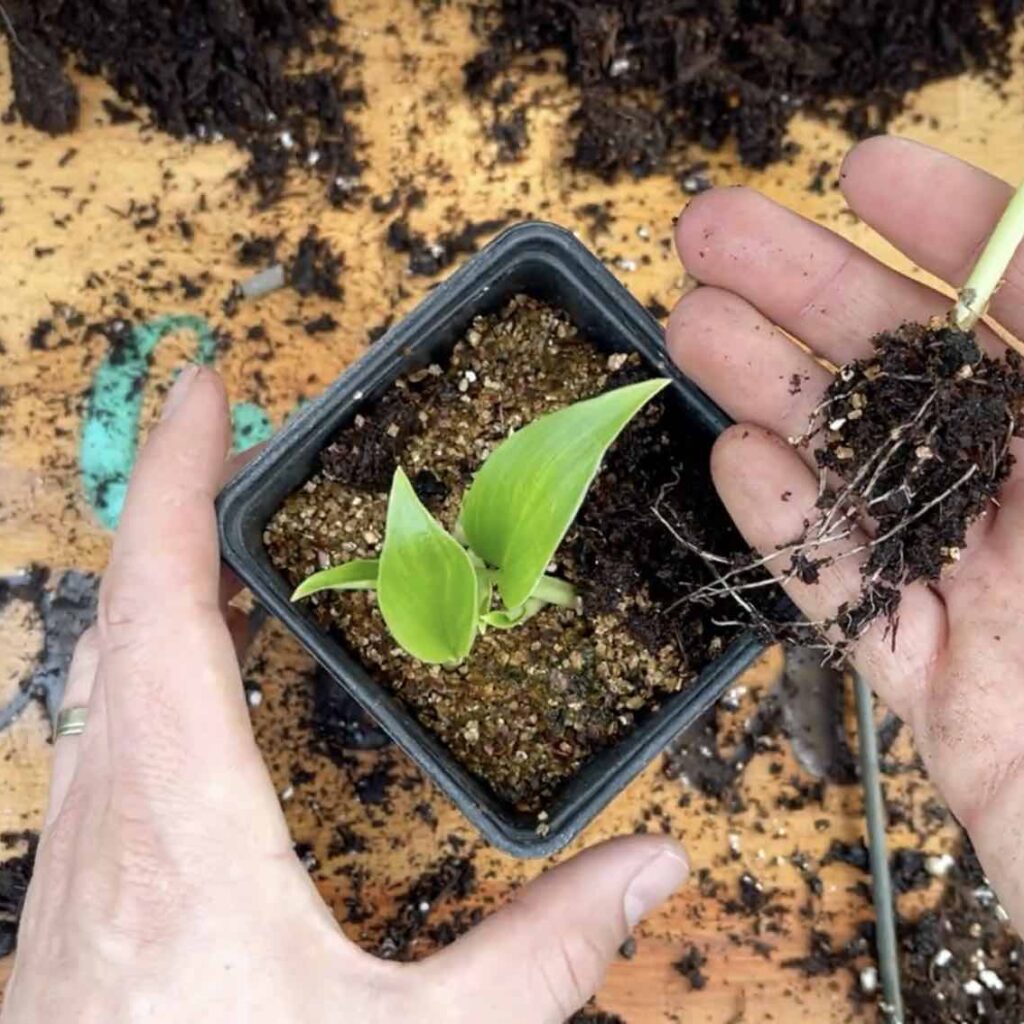
Why Grow Bananas Indoors?
Banana plants (Musa species) are prized for more than just their fruit. Their large, paddle-like leaves add dramatic greenery to any indoor space, making them a favorite among houseplant enthusiasts and urban gardeners alike.
Benefits of growing bananas indoors:
- Adds vibrant, tropical aesthetics to your home.
- Purifies indoor air by removing toxins.
- Fast-growing and easy to maintain with the right setup.
- Some dwarf varieties can produce edible bananas indoors.
Even if you don’t grow them for fruit, indoor banana plants are beautiful foliage plants that can thrive with proper care.
Best Banana Varieties for Indoor Growing
Not all banana plants are suited for indoor conditions. For best results, choose dwarf or compact varieties bred specifically for container growing.
Top Indoor Banana Varieties:
- Dwarf Cavendish (Musa acuminata ‘Dwarf Cavendish’)
Compact, fast-growing, and capable of producing edible bananas indoors with the right care. - Super Dwarf Cavendish
Even smaller than the Dwarf Cavendish, maxing out at 4–5 feet tall — perfect for smaller spaces. - Musa ‘Truly Tiny’
The tiniest banana plant variety, ideal for tabletops or windowsills. - Musa basjoo
Typically grown outdoors, but can adapt to large indoor containers as an ornamental foliage plant.
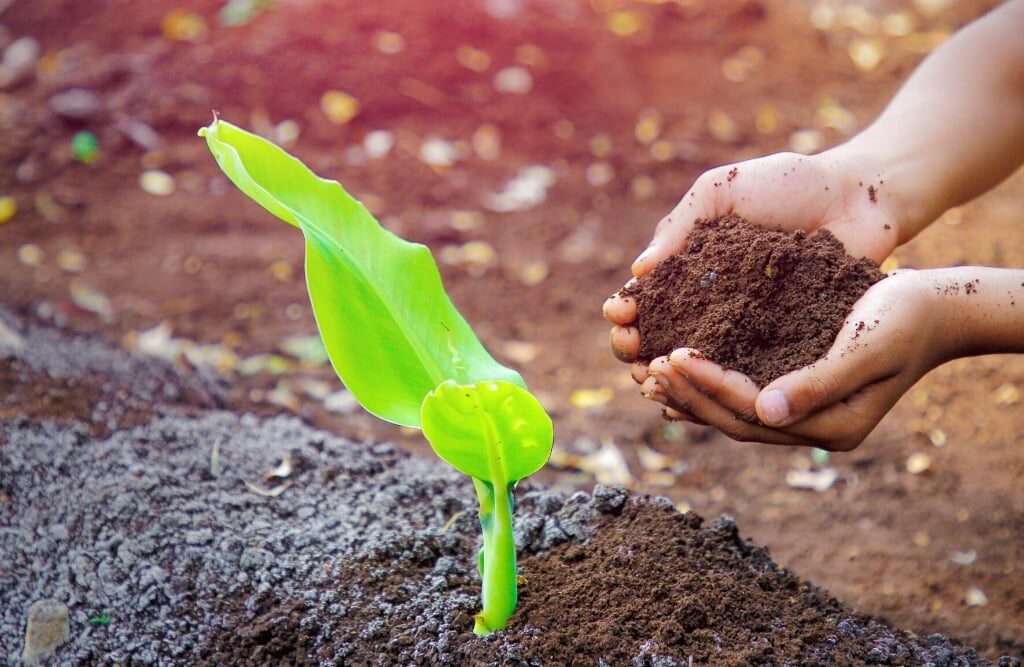
Ideal Conditions for Indoor Banana Plants
To thrive indoors, banana plants need to mimic their native tropical environment as closely as possible.
Light
Banana plants are sun-loving tropicals that need at least 6–8 hours of bright, indirect sunlight daily. Place your plant near a south or east-facing window. You can supplement with a full-spectrum grow light during darker winter months.
Temperature
Maintain indoor temperatures between 75°F and 95°F (24°C to 35°C) for optimal growth. Avoid placing your banana plant near drafts, air conditioners, or cold windows in winter.
Humidity
High humidity is essential. Aim for 50–70% humidity. Boost indoor moisture by:
- Misting the leaves daily.
- Using a pebble tray with water beneath the pot.
- Running a room humidifier nearby.
Soil
Use a well-draining, fertile potting mix rich in organic matter. A mix of peat moss, perlite, and compost works well.
Tip: Ensure your pot has good drainage holes to prevent root rot.
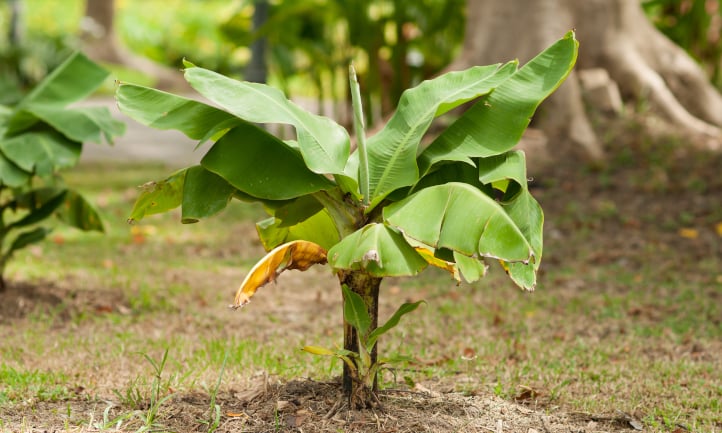
How to Plant a Banana Indoors
Best Planting Time
You can plant a banana tree indoors any time of year, though spring and summer allow for faster establishment thanks to natural warmth and light.
Planting Steps:
- Choose a Large Pot: Start with a container at least 12–14 inches in diameter and deep enough to accommodate growing roots.
- Add Potting Mix: Fill the pot with your prepared soil mix.
- Plant the Banana: Place the banana plant so its root ball is level with the soil surface.
- Water Thoroughly: After planting, give it a good soak until water drains from the bottom.
- Position in Bright Light: Place the plant in a spot with plenty of bright, indirect sunlight.
Caring for Indoor Banana Plants
Bananas are fast growers and respond well to consistent care.
Watering
Banana plants like consistently moist but not soggy soil. Water when the top inch of soil feels dry. In summer, you may need to water every 2–3 days. Reduce watering in winter when growth slows.
Tip: Use room-temperature, filtered water if your tap water is heavily chlorinated.
Fertilizing
Feed your indoor banana plant every 2–3 weeks during the growing season (spring to early fall) using a balanced 10-10-10 liquid fertilizer or organic plant food.
Stop fertilizing in winter when the plant goes dormant.
Pruning
Remove old, yellowing, or damaged leaves at the base with clean scissors. This helps the plant focus energy on new growth.
Repotting
As fast growers, bananas quickly outgrow their containers. Repot every 1–2 years into a slightly larger pot with fresh soil.
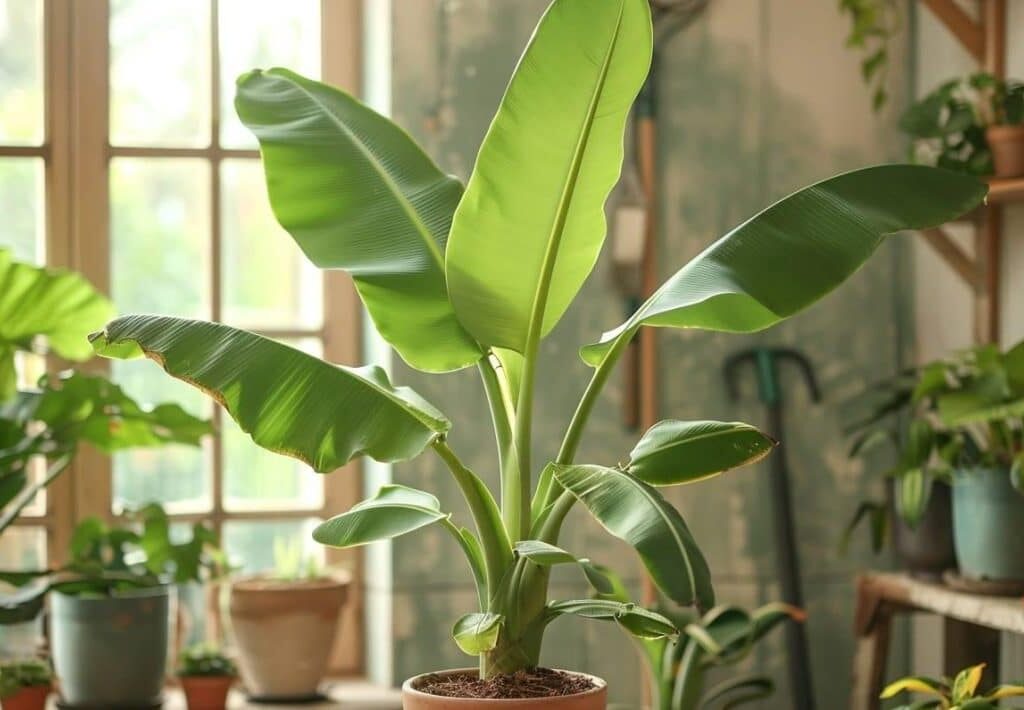
Encouraging Indoor Banana Fruit Production
While many grow bananas indoors for their foliage, some dwarf varieties like Dwarf Cavendish can produce fruit under ideal conditions.
For best chances:
- Provide maximum light via natural sunlight and supplemental grow lights.
- Maintain consistent warmth and humidity.
- Fertilize regularly during active growth.
- Ensure your plant isn’t rootbound — it needs room to grow.
Note: It may take 2–3 years for indoor bananas to flower and fruit.
Common Indoor Banana Plant Problems
Brown Leaf Edges
Cause: Low humidity or inconsistent watering.
Solution: Mist daily, use a humidifier, and maintain even soil moisture.
Spider Mites & Aphids
Bananas can attract common indoor pests. Wipe leaves with a damp cloth and use insecticidal soap or neem oil for infestations.
No Fruit
Lack of sufficient light, warmth, or space can prevent flowering. Ensure ideal tropical-like conditions year-round.
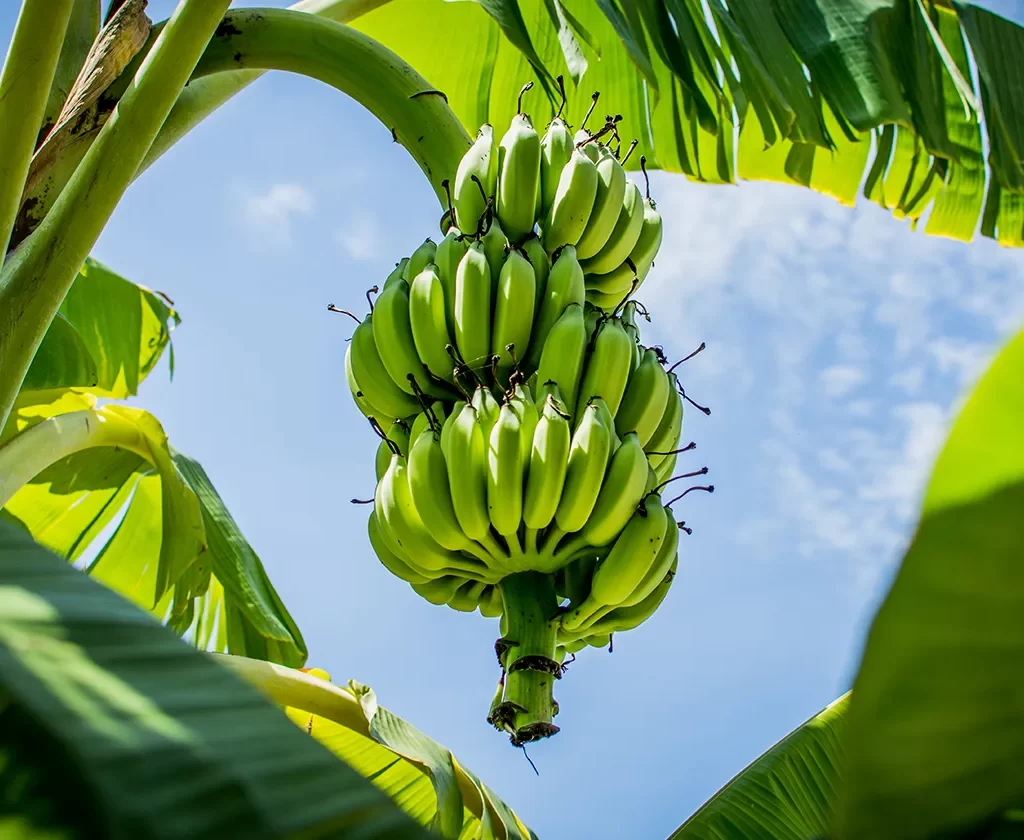
How to Propagate Banana Plants
Banana plants propagate through suckers or pups — small shoots that emerge at the base of the mother plant.
Propagation Steps:
- Wait until pups are at least 12 inches tall.
- Use a sharp, sterile knife to separate the pup with a portion of roots attached.
- Plant the pup in a separate container with well-draining soil.
- Water thoroughly and place in bright light.
This is the easiest way to grow multiple banana plants indoors.
Final Thoughts
Growing bananas indoors may sound ambitious, but with the right care, it’s both rewarding and visually stunning. These tropical beauties brighten up any space with their dramatic leaves and fast growth. And while harvesting bananas indoors can be tricky, it’s not impossible — especially with compact dwarf varieties and careful attention to light, warmth, and humidity.
Whether you’re aiming for tropical decor or hoping to taste your own homegrown bananas, following this guide will set you up for indoor banana-growing success.
FAQs
Q: Can you grow bananas indoors year-round?
A: Yes! With consistent warmth, humidity, and light, bananas can grow indoors year-round.
Q: How big do indoor banana plants get?
A: Dwarf varieties like Super Dwarf Cavendish grow to 4–5 feet, while Dwarf Cavendish can reach 6–8 feet indoors.
Q: Are indoor bananas edible?
A: Yes — if your indoor banana plant flowers and fruits, the bananas are edible.
Q: Do banana plants purify indoor air?
A: Absolutely. Like many large-leafed plants, bananas help filter indoor air and add humidity.

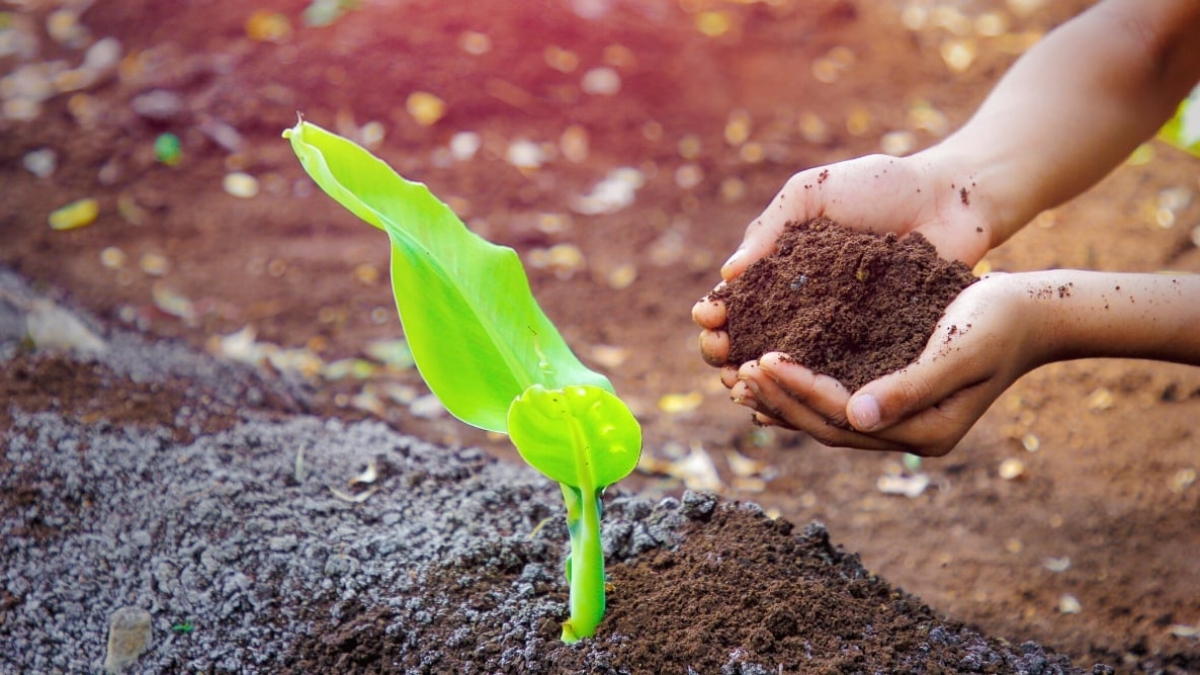





Leave A Comment